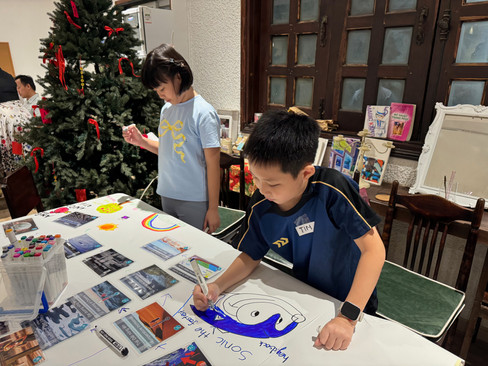🖌️ Creativity & Climate Awareness: A Journey Across Ages
- Trang Nguyen
- Mar 1
- 2 min read
After running 34 Climate Fresk workshops for over 250 participants, a fascinating trend emerged:

With the same materials (Climate Fresk cards, colored markers, sticky notes) and the same guidelines (drawing arrows & blocks, finding a title, highlighting key cards), different age groups and expertise levels displayed strikingly different creative approaches.
🎨 Children (9-14 years old): Their fresks burst with colors, drawings, and playful storytelling, turning climate concepts into expressive art.
🖍️ High school students: Still eager to decorate, they balance structure with creativity, adding personal touches to their fresks.
📋 Adults: Tend to follow the instructions more strictly—drawing connections, titling their fresks—but only those with an interest in art engage in extra decoration.
Cognitive Development and Creativity
Children's creativity often manifests through imaginative play and the ability to think divergently, generating multiple solutions to a given problem. This form of creativity is characterized by free-form exploration and a lack of constraints, allowing children to express novel ideas without self-censorship. As they grow, cognitive development introduces more structured thinking patterns, which can both enhance and limit creative expression.
While adults possess a richer knowledge base and more developed critical thinking skills, these can sometimes hinder the spontaneous generation of novel ideas due to over-reliance on existing schemas and fear of making mistakes.
Research indicates that young children are more imaginatively creative than adults; however, creativity's main neural engine, divergent thinking, relies on memory and logical association, tasks at which young children underperform compared to adults.
-- oscarvenhuis.com --
Environmental and Educational Influences
The environments in which individuals develop play a significant role in nurturing or stifling creativity. In early childhood, supportive family settings that encourage exploration and provide diverse experiences can foster creative thinking. Educational systems, however, often emphasize conformity and standardized testing, which may suppress creative development.
A study commissioned by NASA found that 98% of 4- and 5-year-old children scored at a "creative genius" level, but this percentage drastically declined as they aged, suggesting that traditional schooling may inhibit creative potential.
-- inc.com --
Maintaining and Enhancing Creativity in Adulthood
While creativity may decline with age due to various factors, it is not an inevitable process. Adults can maintain and even enhance their creative abilities by engaging in activities that promote divergent thinking and by creating environments that encourage risk-taking and the exploration of new ideas. Lifelong learning, exposure to diverse perspectives, and the cultivation of curiosity are essential components in sustaining creativity throughout adulthood.
Additionally, societal support for creative endeavors, such as providing platforms for artistic expression and innovation, can help individuals retain their creative capacities over time. Research underscores the importance of environments in fostering creativity, highlighting the significance of creative classroom culture and climate.
-- ijccep.springeropen.com --
In conclusion, while children often display high levels of creativity due to their developmental stage and fewer inhibitions, creativity is a multifaceted trait influenced by cognitive, environmental, and societal factors. Recognizing and addressing the elements that hinder creativity in adulthood can lead to strategies that preserve and enhance creative potential throughout the lifespan.


























Comments